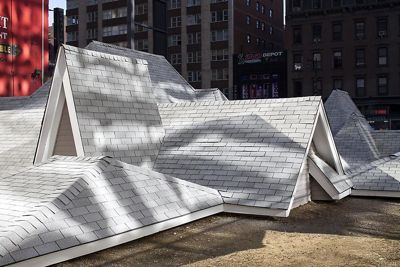David Brooks Tears The Roof Off is an apt title for one of our most recent New York Close Up films this summer. Within the first 60 seconds of a pretty intense tour that runs under eight minutes we get to hear Brooks passionately describe the housing boom that has threatened the Everglades in South Florida, a place he has personally visited for decades. We are then introduced to an installation titled Desert Rooftops inspired by this crisis and completed right here in New York City… literally on the last undeveloped lot in Times Square.
While the housing industry shamelessly encroaches on the protected Everglades, here we see midtown skyscrapers “framing” this “viral” layout of rooftops connected- sprawling- throughout the space. Brooks acknowledges that the work is perhaps difficult at first to recognize as art, but as the viewer engages with it and makes associations it becomes clear that something curious is going on and this isn’t some three-dimensional promo for a roofing company… even if Fox News couldn’t figure it out (and does the anchorwoman say “Home Depot” or “Home Thiebaud”? Just asking).
Brooks’ work can appeal to students in different ways, opening up a mixed bag of questions and assumptions, such as:
- What kinds of things can we use to make art?
- Does having an explanation or narrative help or hinder the viewer’s experience?
- What kinds of associations can viewers make engaging with a work such as this?
- Can public art tell stories that “white cubes” cannot? If so, how… and why?
- How can more artists make environmentally conscious work and not mirror a “resource-devouring” industry like home construction?
Students who watch the film can also investigate how past and present examples of suburban sprawl have affected other places, as well as the things that have been produced by artists and others in response.
Finally, David Brooks talks about Desert Rooftops being “instigated” by the space in Times Square but I think it actually plays a little tug-of-war with it. These rooftops, seeming to grow like weeds from the small plot, are practically being watched and scrutinized by the surrounding buildings that tower over them. They spread throughout the plot quite freely yet the fence reminds everyone that this is the end- this is the edge of the frame. And in this way the work goes on to speak about both sprawl and a kind of containment.
